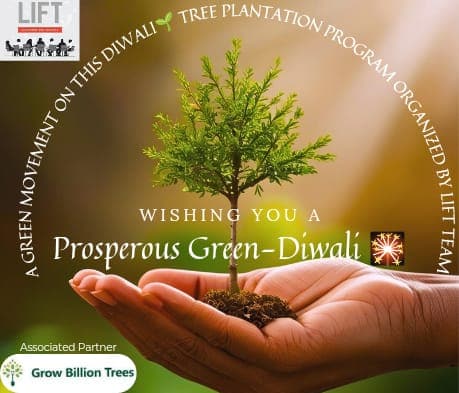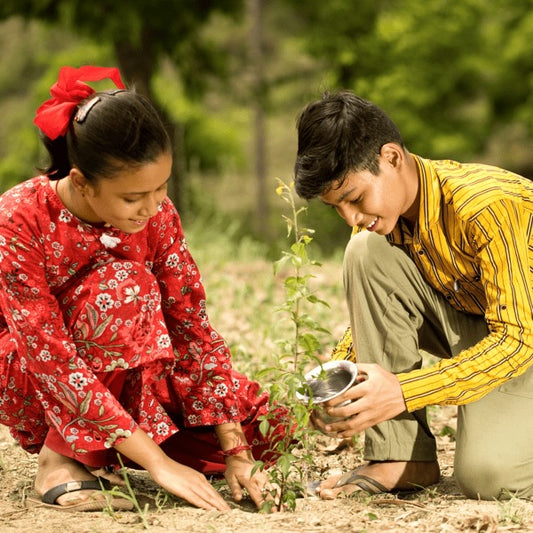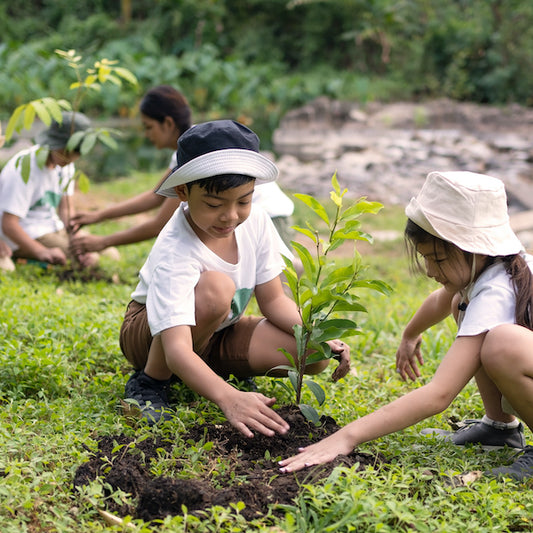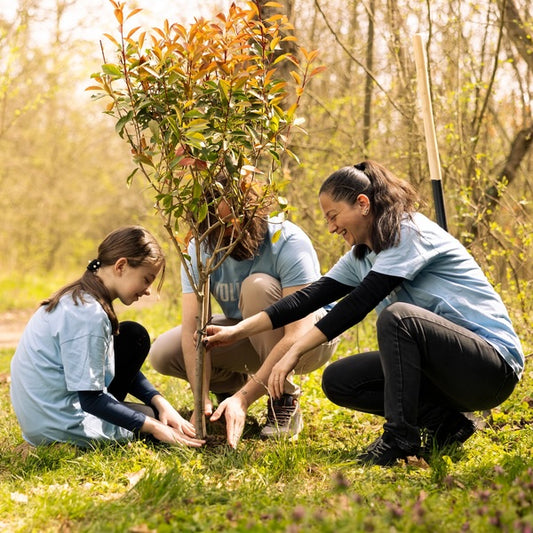InfoBeans' Anniversary Gift: Agroforestry Initiative Marks 5 Years of Client Collaboration
InfoBeans, a leading IT consulting and software development provider, celebrated its 5th anniversary and its longstanding partnership with one of its Read more
Digital Forest
Forest with 50 Trees planned
Want to plant your tree now?
Plant a Tree @ 299InfoBeans' Anniversary Gift: Agroforestry Initiative Marks 5 Years of Client Collaboration
InfoBeans, a leading IT consulting and software development provider, celebrated its 5th anniversary and its longstanding partnership with one of its key clients through a meaningful tree plantation initiative in the agroforest concept. This initiative aligns with InfoBeans' commitment to environmental sustainability and corporate social responsibility. By planting trees, InfoBeans not only commemorated their milestone but also contributed to ecological restoration and biodiversity in agroforests.
The trees planted will offer numerous benefits to farmers, including improved livelihoods, reduced farming costs, and enhanced income sources. Agroforestry practices help increase crop yields, conserve soil quality, and provide additional resources like timber, fruits, and medicinal plants, fostering a more sustainable and profitable farming model. This initiative highlights InfoBeans' dedication to both environmental stewardship and the well-being of local farming communities.
By integrating environmental stewardship with their celebration, InfoBeans emphasized the importance of blending corporate growth with the responsibility of nurturing the planet, ultimately showcasing their commitment to both business and environmental goals.
Tree Plantation Date
25th January 2025
Plantation Location
Rajpur, Barwani, Madhya Pradesh 451447
Trees Planted
Total Count: 50 Trees
Forest Type: Agroforest
InfoBeans celebrated its 5th anniversary by launching a tree plantation initiative in the agroforest concept, reflecting its commitment to environmental sustainability and support for local farming communities. This initiative, aimed at creating a green, sustainable environment, involves planting trees in agroforestry systems that provide multiple benefits to farmers. By integrating trees with crops, farmers can improve soil fertility, reduce erosion, and enhance biodiversity. Agroforestry also helps reduce farming costs by diversifying income sources through the production of timber, fruits, and other tree products. It provides farmers with additional resources, ensuring a more stable and profitable livelihood while promoting long-term environmental health and sustainability. This initiative underscores InfoBeans’ dedication to fostering both technological innovation and the well-being of agricultural communities.
Advantages Of Agroforest
Enhanced Income Diversification
The agroforest concept enables farmers to diversify their sources of income by integrating trees with their crops. This diversification includes products like timber, fruits, nuts, medicinal plants, and fuelwood, which can significantly increase a farmer's revenue stream. By offering multiple products, farmers are less vulnerable to market fluctuations or crop failures, leading to more stable financial returns over time.
Improved Livelihood Resilience
Agroforestry helps farmers build resilience against climate change and environmental challenges. The trees planted in agroforestry systems provide shade and windbreaks that protect crops from extreme weather conditions, such as droughts and heavy rainfall. By improving the microclimate and soil health, agroforestry systems ensure more consistent yields, enhancing the overall livelihoods of farmers, even in the face of unpredictable climate patterns.
Reduced Farming Costs
One of the key benefits of agroforestry is its ability to reduce farming costs. The trees planted in these systems help to enrich the soil with organic matter and improve its structure, reducing the need for chemical fertilizers and pesticides. Additionally, agroforestry systems can help conserve water and reduce irrigation costs by improving soil moisture retention. This leads to long-term savings for farmers, making their farming practices more cost-effective.
Soil Fertility and Erosion Control
The integration of trees in agroforestry systems plays a crucial role in preventing soil erosion and maintaining soil fertility. Tree roots bind the soil, reducing runoff and preventing degradation. Moreover, the organic matter from fallen leaves and decomposed plant material enriches the soil, enhancing its fertility and structure. This results in healthier soil, which leads to better crop yields over time.
Increased Biodiversity
Agroforestry systems create habitats for a wide range of plant and animal species, increasing biodiversity in agricultural landscapes. By planting diverse tree species, farmers help maintain a balance in local ecosystems, supporting pollinators, birds, and beneficial insects that enhance crop production. This increase in biodiversity can also lead to natural pest control, reducing the need for chemical pesticides and promoting a healthier farming environment.
Long-Term Sustainability and Environmental Health
The adoption of agroforestry practices contributes to environmental sustainability by sequestering carbon, improving air quality, and reducing the overall carbon footprint of agricultural activities. The trees in agroforestry systems help in capturing carbon from the atmosphere, mitigating the effects of climate change, and improving overall environmental health. This long-term sustainability benefits not only the farmers but also the broader community and ecosystem.
Improved Water Management
Agroforestry systems improve water infiltration and reduce water runoff by enhancing soil structure. This helps conserve water and ensures more efficient use of available resources, particularly in areas where water is scarce. The trees' deep roots also help in accessing groundwater, reducing the need for external water sources and contributing to more efficient farming practices.
Activities During Tree Plantation
During InfoBeans' tree plantation initiative, the site was carefully prepared by farmers prior to the plantation day, ensuring that the ground was ready for the saplings. On the day of the activity, pre-dug pits were used to plant the saplings, which were selected to thrive in the agroforestry system. The plantation process involved placing the young trees into the pits, ensuring proper spacing and alignment for optimal growth. Following the planting, the saplings were thoroughly watered to help them establish roots and adapt to their new environment. This simple yet effective approach not only contributes to the green initiative but also fosters sustainable agricultural practices in the region.
Tree Plantation Purpose
Sustainable Development Goals (SDGs) Achieved Through InfoBeans’ Tree Plantation Initiative in Agroforest Manner:
1. SDG 1: No Poverty
The agroforestry initiative contributes to poverty reduction by enhancing farmers' income and livelihoods. By diversifying income sources through the cultivation of tree products like timber, fruits, and medicinal plants, farmers experience improved financial stability. This diversified income stream can help alleviate poverty in rural areas by providing farmers with multiple revenue-generating options, thus reducing dependency on single-crop agriculture.
2. SDG 2: Zero Hunger
Agroforestry practices improve food security by boosting agricultural productivity. Trees integrated into farming systems enhance soil fertility, prevent erosion, and improve crop yields. The inclusion of fruit-bearing trees, legumes, and other crops in agroforestry systems directly contributes to local food supply, ensuring a more sustainable and diverse food source for communities, while reducing the risk of hunger caused by climate-related crop failures.
3. SDG 3: Good Health and Well-being
The agroforestry initiative contributes to improving public health by enhancing the local environment. The trees planted in agroforestry systems help purify the air by absorbing carbon dioxide and releasing oxygen. This leads to improved air quality, which benefits the health of the local population, particularly in rural areas where access to healthcare may be limited. Additionally, by providing farmers with diverse and nutritious crops, agroforestry helps support better dietary diversity and health outcomes.
4. SDG 4: Quality Education
The tree plantation initiative provides educational opportunities for farmers and the broader community. Through training and hands-on experience in agroforestry practices, farmers learn valuable skills in sustainable farming techniques, environmental stewardship, and tree care. This initiative promotes lifelong learning and skill development, empowering local communities with the knowledge needed to adopt more sustainable farming methods. The awareness raised through the initiative can also lead to greater environmental education within local schools and communities.
5. SDG 6: Clean Water and Sanitation
Agroforestry systems enhance water management by improving soil structure, reducing runoff, and increasing water retention in the soil. This leads to better water conservation and improved water quality. Additionally, the deep roots of trees help prevent groundwater depletion and contribute to the sustainable use of water resources, which is vital for both agriculture and local communities.
6. SDG 8: Decent Work and Economic Growth
The agroforestry initiative promotes economic growth in rural areas by creating new job opportunities in tree planting, maintenance, and the harvesting of agroforest products. It empowers farmers with skills to manage diversified farming practices, improving their resilience to economic challenges and creating more sustainable livelihoods. By fostering local economic development, the initiative contributes to the broader goal of decent work and sustainable economic growth.
7. SDG 12: Responsible Consumption and Production
Through the adoption of agroforestry, InfoBeans encourages sustainable farming practices that contribute to responsible consumption and production. Agroforestry systems reduce the need for chemical inputs, like fertilizers and pesticides, by promoting organic farming methods. By integrating trees, which naturally improve soil fertility, farmers reduce the environmental impact of conventional agriculture, contributing to more sustainable production methods.
8. SDG 13: Climate Action
The tree plantation initiative plays a crucial role in mitigating climate change. Trees sequester carbon, reducing the amount of CO2 in the atmosphere, and thus contributing to the fight against global warming. Agroforestry systems help farmers adapt to climate-related challenges, such as droughts and extreme weather events, by providing better water retention and soil quality, enhancing resilience to climate impacts.
9. SDG 15: Life on Land
The agroforest concept supports biodiversity conservation and ecosystem restoration. By planting trees alongside crops, the initiative helps restore degraded land, promotes soil health, and creates habitats for various species. These actions contribute to the broader goal of sustaining terrestrial ecosystems, preserving biodiversity, and preventing land degradation.
10. SDG 17: Partnerships for the Goals
InfoBeans' partnership with Grow Billion Trees has played a pivotal role in achieving SDG 17: Partnerships for the Goals by fostering a collaborative approach to environmental sustainability. Through this partnership, InfoBeans has contributed to large-scale tree plantation initiatives, enhancing agroforestry systems and supporting local farming communities. Grow Billion Trees’ expertise in ecological restoration and sustainable practices has helped maximize the impact of the tree plantation efforts, ensuring that trees are planted in areas where they can thrive and benefit both the environment and farmers. By combining InfoBeans’ technological innovation with Grow Billion Trees' focus on ecological impact, the partnership has not only accelerated environmental stewardship but also empowered farmers with the knowledge and resources needed to sustain their livelihoods, thereby driving progress toward the achievement of multiple SDGs.
ESGs Achieved Through Agroforestry
Environmental (E)
InfoBeans' tree plantation initiative in the agroforest concept significantly contributes to environmental sustainability. By planting trees alongside agricultural crops, the initiative promotes biodiversity, reduces soil erosion, and improves soil health through organic matter from decaying plant material. These trees also enhance water retention in the soil, which is crucial for preventing water scarcity. Additionally, the trees sequester carbon, helping mitigate climate change by absorbing carbon dioxide from the atmosphere. This combination of improved agricultural practices and environmental restoration helps restore degraded lands, ensuring long-term environmental resilience and sustainability.
Social (S)
The social impact of InfoBeans' tree plantation initiative is profound, particularly in supporting local farming communities. The initiative enhances farmers' livelihoods by providing them with diverse income sources through agroforestry products like timber, fruits, and medicinal plants. By reducing dependency on single-crop farming, it creates more stable economic conditions for farmers, especially in regions affected by climate change. Moreover, the initiative fosters community engagement by involving local farmers in sustainable land management practices, empowering them with new knowledge and skills that improve their agricultural productivity and long-term well-being.
Governance (G)
InfoBeans demonstrates strong governance through its partnership with Grow Billion Trees, ensuring that the tree plantation initiative is conducted with transparency, accountability, and integrity. The initiative is designed with a clear focus on sustainability, and the company ensures that its actions align with both environmental goals and ethical practices. InfoBeans ensures that the project adheres to environmental standards, engages with local stakeholders, and operates within the guidelines of corporate responsibility. This governance model strengthens the company's commitment to ESG principles, enhancing its reputation as a responsible corporate entity dedicated to fostering positive environmental and social change.
Commitment by Grow Billion Trees
Grow Billion Trees is committed to driving sustainable plantation efforts, ensuring every initiative aligns with key environmental objectives and promotes long-term ecological balance. We focus on selecting native tree species that are well-adapted to local ecosystems, ensuring a higher survival rate and stronger environmental impact.
To maintain plant health and longevity, Grow Billion Trees emphasizes continuous maintenance and regular monitoring of the plantations. This approach helps ensure that each tree thrives, contributing effectively to both biodiversity and climate resilience.
Transparency is a core principle in our operations. Clients receive comprehensive reports, including geo-tagging of planted trees, survival rate updates, and ongoing progress reports. This level of openness allows clients to track the direct impact of their contributions, reinforcing trust and accountability.
Through our dedication to sustainable practices, Grow Billion Trees ensures that every plantation project leaves a lasting positive footprint on both the environment and the local communities it serves.
Summary
InfoBeans celebrated its 5th anniversary by launching a tree plantation initiative in the agroforest concept, marking five years of successful partnership with one of their clients. The initiative focuses on enhancing environmental sustainability by planting trees that integrate with agricultural systems to benefit local farmers. Agroforestry practices improve soil health, reduce erosion, and provide additional income sources through products like timber, fruits, and other tree-based resources. This initiative not only helps foster a greener, healthier environment but also empowers farmers by offering them more resilient, diversified livelihoods. Through this gesture, InfoBeans highlights its commitment to both technological innovation and environmental stewardship, creating long-term value for the community and promoting sustainability in agriculture.
Trees for Corporates
Trending
Most Popular
1. Tree Plantation Initiative by InfoBeans
InfoBeans doesn’t just code; they cultivate! Their tree plantation initiative celebrates their 5th anniversary with a green twist, turning milestones into saplings. Collaborating with farmers, InfoBeans is embracing agroforestry, where trees share the land with crops, creating a symbiotic ecosystem. It’s a win-win—trees boost soil fertility while offering fruits, timber, and shade, and farmers get diversified income sources. Beyond the spreadsheets, InfoBeans is sowing seeds of sustainability, proving tech companies can nurture both innovation and nature. By blending corporate responsibility with environmental stewardship, InfoBeans is making sure their legacy grows as deep as their roots. Green coding? Check. Green planet? Double check!
2. Agroforestry Benefits for Farmers
trees standing tall, shielding crops from harsh winds, and enriching the soil with organic goodness. Farmers reap the rewards of reduced farming costs and diversified income through timber, fruits, and medicinal plants. Plus, with improved water retention and climate resilience, they’re not just surviving—they’re thriving! Thanks to InfoBeans’ tree plantation initiative, agroforestry is no longer just a buzzword but a lifeline for farmers, giving them the tools to combat challenges and embrace a sustainable, prosperous future. Who knew trees could be so profitable?
3. Sustainable Development Goals and Tree Planting
growing trees, fixing problems, and making the planet smile. Who knew a tech company could make such a huge eco-impact? InfoBeans is here to prove that every line of code—and every sapling—counts toward a better world.
4. Corporate Social Responsibility (CSR) by InfoBeans
Move over, boring CSR activities—InfoBeans is rewriting the playbook with their agroforest tree plantation initiative! Celebrating their 5th anniversary with a client, InfoBeans has turned a simple milestone into an eco-friendly fiesta. By involving farmers in planting trees that support their livelihood, InfoBeans merges social impact with sustainability. This isn’t just corporate responsibility; it’s corporate awesome-bility! By prioritizing people and the planet, InfoBeans is setting the gold standard for how businesses can grow their bottom line while growing forests. Talk about making a real difference, one sapling at a time.
5. InfoBeans’ Partnership with Grow Billion Trees
When InfoBeans partnered with Grow Billion Trees, it was a match made in eco-heaven! Together, they’re championing agroforestry and giving farmers the tools to thrive. Grow Billion Trees ensures the groundwork—literally—by preparing sites, while InfoBeans provides the resources and vision to make it happen. The result? Thriving agroforests that boost biodiversity, combat climate change, and transform communities. This partnership isn’t just about planting trees; it’s about planting hope, resilience, and sustainability. Who needs superheroes when you have partnerships like this? Saving the world, one tree at a time.
6. InfoBeans’ Green Milestone Celebration
InfoBeans doesn’t just celebrate anniversaries—they plant them! To mark five years with a valued client, InfoBeans chose trees over confetti and agroforests over parties. By planting trees in pre-prepared agroforestry plots, they’ve created a legacy that grows greener with each passing year. This isn’t just a celebration; it’s a commitment to sustainability and community empowerment. InfoBeans has shown that milestones can be meaningful, and corporate celebrations can change lives—both for farmers and the planet. After all, what’s a better gift than a greener Earth?
7. Environmental Impact of Agroforests
Agroforests aren’t just pretty—they’re powerhouses of environmental goodness! InfoBeans’ initiative ensures these green marvels do their part by sequestering carbon, improving soil health, and boosting biodiversity. They act as natural air purifiers, water reservoirs, and erosion preventers. Thanks to agroforests, the planet gets a much-needed breather from deforestation and climate change. InfoBeans has turned tree planting into an art form, showing that tech companies can have roots—literally. It’s not just about growing trees; it’s about growing a future where the environment thrives.
8. InfoBeans’ Commitment to Farmers
At InfoBeans, farmers are the real MVPs of their tree plantation initiative. By adopting the agroforest concept, InfoBeans ensures that farmers benefit directly through improved soil quality, reduced farming costs, and diversified income from timber and fruits. This isn’t charity—it’s empowerment. Farmers gain skills, resilience, and sustainable practices that outlast seasons and trends. InfoBeans’ commitment goes beyond planting trees; it’s about planting opportunities and building a future where farmers and ecosystems flourish side by side. Now that’s what we call growth—literally and figuratively!
FAQ
What is InfoBeans' tree plantation initiative in the agroforest concept?
InfoBeans' tree plantation initiative focuses on enhancing agroforestry systems, where trees are planted alongside crops to improve soil health, reduce erosion, and boost farmers’ income. This initiative celebrates InfoBeans' 5th anniversary in partnership with a client and aims to foster environmental sustainability while providing local farmers with diversified income streams from products like timber, fruits, and medicinal plants. It emphasizes the long-term health of the land and community resilience against climate change.
What are the benefits of agroforestry for farmers?
Agroforestry offers farmers several benefits, such as increased income diversification through tree-based products like fruits, timber, and medicinal plants. It enhances soil fertility, prevents erosion, and improves water retention, which can reduce farming costs. Additionally, agroforestry helps farmers adapt to climate change by providing shade for crops, mitigating heat stress, and promoting biodiversity, ultimately improving their resilience and livelihood sustainability.
How does agroforestry contribute to environmental sustainability?
Agroforestry helps in environmental sustainability by promoting biodiversity, reducing soil erosion, and improving soil fertility. The trees planted in agroforestry systems act as carbon sinks, absorbing carbon dioxide and improving air quality. These trees also enhance water retention in the soil, leading to better drought resilience and reduced water consumption. Through these ecological benefits, agroforestry creates a healthier, more sustainable environment for both farming communities and the planet.
What role does InfoBeans play in promoting environmental sustainability?
At InfoBeans, we believe in fostering environmental sustainability through initiatives like our tree plantation project. By integrating agroforestry into farming systems, we help reduce the environmental impact of conventional farming practices. Our efforts not only contribute to tree planting but also promote smarter, more sustainable agricultural practices that benefit local farmers, enhance biodiversity, and support the fight against climate change, reinforcing our commitment to corporate responsibility and environmental stewardship.
How does the tree plantation initiative benefit the local community?
InfoBeans’ tree plantation initiative directly benefits the local community by providing farmers with a sustainable and diversified source of income. Agroforestry systems offer improved soil health, water retention, and biodiversity, which lead to more resilient farming practices. Additionally, farmers gain new skills and knowledge through the initiative, enabling them to adopt sustainable farming techniques that increase their productivity and long-term income stability, while improving overall community well-being.
What is the significance of celebrating InfoBeans’ 5th anniversary through a tree plantation initiative?
Celebrating our 5th anniversary with a tree plantation initiative is a reflection of our commitment to sustainability and community development. By planting trees as part of our agroforestry efforts, we not only mark an important milestone in our relationship with a valued client but also contribute to environmental and social goals. It’s our way of ensuring that our growth aligns with the betterment of both the environment and the communities we serve.
How does tree planting in agroforestry help combat climate change?
Tree planting in agroforestry systems plays a key role in combating climate change by sequestering carbon dioxide, one of the primary greenhouse gases. The trees absorb carbon during photosynthesis and store it in their biomass. This helps reduce the overall concentration of carbon dioxide in the atmosphere. Additionally, agroforestry practices promote healthy ecosystems, improve water management, and enhance soil fertility, all of which contribute to climate change mitigation and adaptation.
Can farmers in India participate in agroforestry projects like InfoBeans’?
Yes, farmers in India can participate in agroforestry projects like the one spearheaded by InfoBeans. We aim to provide support and resources for local farmers to implement agroforestry systems on their land. These projects offer practical training, access to new agricultural techniques, and the opportunity to diversify their income streams. By participating, farmers can improve their land’s productivity and sustainability, all while contributing to environmental conservation.
What types of trees are planted in the agroforestry initiative?
In our agroforestry initiative, a variety of trees are planted, selected based on their suitability for the local climate and soil conditions. These may include fruit-bearing trees, timber species, and trees that offer medicinal or other marketable products. Each type of tree is chosen to ensure compatibility with the crops grown by farmers, promoting a balanced ecosystem that supports both agriculture and biodiversity, while providing economic opportunities for farmers.
How does InfoBeans ensure the success of its tree plantation projects?
InfoBeans ensures the success of its tree plantation projects by working closely with local farmers and experts to implement sustainable agroforestry practices. We provide necessary training, resources, and continuous support to ensure proper planting, care, and maintenance of trees. Additionally, our partnership with Grow Billion Trees ensures that the project is executed in a way that maximizes environmental and social impact. Through careful planning and collaboration, we aim to create lasting positive change in the communities we work with.
- Choosing a selection results in a full page refresh.
- Opens in a new window.












